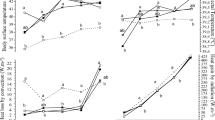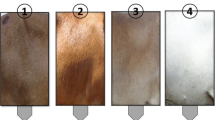Abstract
Coat color is a factor affecting heat tolerance in tropical ruminant and a particular coat color can determine which is more resilient to environmental changes. The aim of this study was to measure the level of adaptation of Morada Nova sheep with different coat color by using an Adaptability Index (AI). Adult ewes were used, including two different coat colors of Morada Nova sheep (red and white) with mean of body weight of 28.02 ± 5.70 kg and 31.47 ± 3.41 kg, respectively. Physiology parameters, hematology, electrolytes, acid–base status, mineral, renal functions, metabolites, enzymes, and proteins were measured. AI was designed using a multivariate approach (principal component analysis) to "weigh" the influence of each variable in the animal responses. The variables more important for adaptive aspects of Red Morada Nova were: haematology, electrolytes and acid–base status. The hemoglobin (HG), mean corpuscular hemoglobin (MCH), mean corpuscular hemoglobin concentration (MCHC), sodium (Na+), oxygen pressure (PO2), glucose (GLU) and albumin (ALB) were significantly higher in Red Morada Nova sheep and hydrogen carbonate (HCO3), base excess (BE), total carbon dioxide concentration (TCO2) and URE were significantly higher in the white phenotype. The variables more important for adaptive aspects of White Morada Nova sheep were: (K+), total protein (TP), PO2, HG, cholesterol (CHO), rectal temperature (RT) and glucose (GLU). Both phenotypes showed a high adaptation level, however, a higher value was generated for the Red Morada Nova sheep (81.97). This study concludes that both phenotypes of the Morada Nova sheep breed are well adapted to the climatic condition of the Brazilian tropical region using different adaptive mechanisms.



Similar content being viewed by others
Data Availability
Database used for analysis: https://1drv.ms/x/c/651d44d610bd1ce1/EVNzXV8DJ5FDjmWiCTxTQpoB5EWcAmAwqfgRp5DtZvflow.
References
Alvares CA, Stape JL, Sentelhas PC, Gonçalves JLM, Sparovek G (2013) Koppen’s climate classification map for Brazil. Meteorol Z 22:711–728. https://doi.org/10.1127/0941-2948/2013/0507
Araújo GGL, Costa SAP, Moraes SA, Queiroz MAA, Gois GC, Santos NMSS, Albuquerque IRR, Moura JHA, Campos FS (2019) Supply of water with salinity levels for Morada Nova sheep. Small Rumin Res 171:73–76. https://doi.org/10.1016/j.smallrumres.2019.01.001
Arfuso F, Giannetto C, Giudice E, Assenza A (2021) Daily dynamic changes of blood acid-base status and vital parameters in lambs and goat kids over the first seven days after birth. Small Rumiant Research 197:106340. https://doi.org/10.1016/j.smallrumres.2021.106340
Carlos MML, Leite JHGM, Chaves DF, Vale AM, Façanha DAE, Melo MM, Soto-Blanco B (2015) Blood parameters in the Morada Nova sheep: influence of age, sex and body condition score. J Anim Plant Sci 25:950–955
Castro MSM, Vasconcelos AM, Santos VO, Lopes AKC, Farias MRS, Lima FRG, Rogério MCP, Ferreira J, Silveira RMF (2020) Thermoregulatory capacity of Santa Inês hair ewes of different genotypes associated with coat colors raised in a hot environment. J Appl Anim Welfare Sci. https://doi.org/10.1080/10888705.2020.1819808
Cattell RB (1966) The scree test for the number of factors. J Multivariate Behav Res 1:245–276. https://doi.org/10.1207/s15327906mbr0102_10
Costa WP, PimentaFilho EC, Leite JHG, Silva WST, Silva WE, Lima FHS, PeixotoJúnior GNA, Façanha DAE (2018) Coat characteristics and physiological responses of locally adapted ewes in semiarid region of Brazil. Semin: Ciênc Agrár 39:1281–1294. https://doi.org/10.5433/1679-0359.2018v39n3p1281
David CMG, Quirino CR, Vega WHO, Bartholazzi Junior A, Madella-Oliveira AF, Costa RLD (2018) Diversity of indigenous sheep of an isolated population. BMC Vet Res 14:1–7. https://doi.org/10.1186/s12917-018-1682-y
David CMG, Luquetti BC, Costa RLD, Bonello FL (2012) Padrão hematológico de cordeiros da raça Santa Inês criados na região oeste do estado de São Paulo. Boletim de Indústria Animal (Online) 69(1):79–84. http://www.iz.sp.gov.br/bia/index.php/bia/article/view/1046/1040
Eloy AMX (2007) Estresse na produção animal. Embrapa Caprinos e Ovinos. Comunicação técnica, 87, Sobral: Embrapa caprinos e ovinos, 7p
Façanha DAE, Ferreira J, Silveira RMF, Morais FX, Medeiros CC, Facó O, Sousa JER, de Paula VV (2021) Thermoregulatory responses, and acid–base and electrolytic balance of indigenous ewes of different coat colour in an equatorial semi-arid region. J Anim Sci 100:103027. https://doi.org/10.1071/AN20321
Ferreira JSB, Paiva SR, Silva EC, McManus CM, Caetano AR, Façanha DAE, Sousa MAN (2014) Genetic diversity and population structure of different varieties of Morada Nova hair sheep from Brazil. Genet Mol Res 13:2480–2490. https://doi.org/10.4238/2014.April.3.20
Ferreira J, Silveira RMF, Sousa JER, Façanha DAE (2020) Locally adapted goats efficiently gain and lose heat in an equatorial semi-arid environment. Int J Bioclimatol 64:1777–1782. https://doi.org/10.1007/s00484-020-01959-0
Ferreira J, Silveira RMF, Sousa JER, Vasconcelos AM, Guilhermino MM, Façanha DAE (2021) Evaluation of homeothermy, acid-base and electrolytic balance of black goats and ewes in an equatorial semi-arid environment. J Therm Biol 100:103027. https://doi.org/10.1016/j.jtherbio.2021.103027
Freitas ACB, Costa RLD, Quirino CR, Bartholazzi Junior A, Beltrame RT, Campos FP (2020) The effects of genetic group and sex on residual feed intake, performance, morphometric, testicular, and carcass traits in lambs. An Acad Bras Ciênc 92:e20190340. https://doi.org/10.1590/0001-3765202020190340
Freitas ACB, BhartolazziJúnior A, Quirino CR, Dias da Costa RL (2021) Water and food utilization efficiencies in sheep and their relationship with some production traits. Small Rumin Res 197:106334. https://doi.org/10.1016/j.smallrumres.2021.106334
Freitas LA, Savegnago RP, Menegatto LS, Bem RD, Stafuzza NB, Paz ACAR, Pires BV, Costa RLD, Paz CCP (2022) Cluster analysis to explore additive-genetic patterns for the identification of sheep resistant, resilient and susceptible to gastrointestinal nematodes. Vet Parasitol 301:109640. https://doi.org/10.1016/j.vetpar.2021.109640
Geraldo AT, Bartholazzi Junior A, David CMG, Freitas ACB, Antunes F, Rua MAS, Vega WHO, Jardim JG, Mello LM, Correa TS, Beltrame RT, Costa RLD, Quirino CR (2020) Body tissue development of Santa Inês breed sheep using computed tomography. Anim Prod Sci 61:191–200. https://doi.org/10.1071/AN20084
Gurgeira DN, Crisostomo C, Sartori LVC, Paz CCP, Delmilho G, Canul AJC, Bedoya HJN, Vega WHO, Bueno MS, Costa RLD (2022) Characteristics of growth, carcass and meat quality of sheep with different feed efficiency phenotypes. Meat Sci 194:108959. https://doi.org/10.1016/j.meatsci.2022.108959
Hair Jr JF, Anderson RE, Tatham RL, Black WC (2005) Análise multivariada de dados. Porto Alegre: Bookman, pp. 583
Issakowicz J, Issakowicz ACKS, Bueno MS, Costa RLD, Geraldo AT, Abdalla AL, McManus C, Louvandini H (2018) Crossbreeding locally adapted hair sheep to improve productivity and meat quality. Sci Agric 75:288–295. https://doi.org/10.1590/1678-992X-2016-0505
Kaiser HF (1960) The application of electronic computers to factor analysis. Educ Psychol Meas 20:141–151. https://doi.org/10.1177/001316446002000116
Leite JHGM, Silva RG, Silva WST, Silva WE, Paiva RDM, Sousa JER, Asensio LAB, Façanha DAE (2018a) Locally adapted Brazilian ewes with different coat colors maintain homeothermy during the year in a equatorial semiarid environment. Int J Biometeorol 62:1635–1644. https://doi.org/10.1007/s00484-018-1563-x
Leite JHGM, Asensio LAB, Silva WST, Silva WE, Chaves DF, Facó O, Costa WP, Façanha DAE (2018b) Locally adapted brazilian sheep: a model of adaptation to Semiarid region. Sem: Ciênc Agrár 39:2261–2272. https://doi.org/10.5433/1679-0359.2018v39n5p2261
Leite JHGM, Silva RG, Asensio LAB, Sousa JER, Silva WST, Silva WE, Façanha DAE (2020) Coat color and morphological hair traits influence on the mechanisms related to the heat tolerance in hair sheep. Int J Biometeorol 64:2185–2194. https://doi.org/10.1007/s00484-020-02014-8
Machado R, Corrêa RF, Barbosa RT, Bergamaschi MACM (2008) Circular técnico 57: Escore de condição corporal e sua aplicação no manejo reprodutivo de ruminantes, 1ªedição. EMBRAPA, São Carlos, pp. 16
Maia ASC, da Silva RG, Nascimento ST, Nascimento CCN, Pedrosa HP, Domingos HGT (2015) Thermoregulatory responses of goats in hot environment. Int J Biometerology 59:1025–1030. https://doi.org/10.1007/s00484-014-0916-3
McManus C, Louvandini H, Gugel R, Sasaki LCB, Bianchini E, Bernal FEM, Paiva SR, Paim TP (2011) Skin and coat traits in sheep in Brazil and their relation with heat tolerance. Trop Anim Health Prod 43(1):121–126
McManus CM, Lucci CM, Maranhão AQ, Pimentel D, Pimentel F, Paiva SR (2022) Response to heat stress for small ruminants: physiological and genetic aspects. Livest Sci 105028
Muniz MMM, Caetano AR, McManus C, Cavalcanti LCG, Façanha DAE, Leite JHGM, Facó O, Paiva SR (2016) Application of genomic data to assist a community-based breeding program: a preliminary study of coat color genetics in Morada Nova sheep. Livest Sci 190:89–93
Nunes SF, Ferreira J, Paiva SR, Faria DA, Sousa JER, Soares CEA, Silveira RMF, Mourão GB, Façanha DAE (2022a) Fine genetic structure of Brazilian white Morada Nova hair sheep breed from semi-arid region. Small Rumin Res 211:106694. https://doi.org/10.1016/j.smallrumres.2022.106694
Nunes SF, Ferreira J, Silveira RMF, Sales DC, Sousa JER, Paiva SR, Façanha DAE (2022b) Morphometric characterization and zoometric indices of white Morada Nova breed: the first step for conservation. Small Rumin Res 192:106178. https://doi.org/10.1016/j.smallrumres.2020.106178
Ortolani EL (2018) Diagnóstico e tratamento de alterações ácido-básicas em ruminantes. in: Doze leituras em bioquímica clínica veterinária / Félix González, editor. – Porto Alegre: Faculdade de Veterinária, Universidade Federal do Rio Grande do Sul, 2018
Paz CCP, Venturini GC, Contini E, Costa RLD, Lameirinha LP, Quirino CR (2018) Nonlinear models of Brazilian sheep in adjustment of growth curves. Czech J Anim Sci 63:331–338. https://doi.org/10.17221/87/2017-CJAS
Pinheiro JS, Eleutério P, Silva SP, Herbster CJL, Oliveira VV, Cipriano JA, Cardoso SC, Andrade DR, Barbosa ABS, Gadelha CRF, Pereira ES, Martins GA, Campos ACN (2020) Reproductive and productive characteristics of hair sheep raised in the tropical region grassland of Brazil. Res Soc Dev. https://doi.org/10.33448/rsd-v9i9.7287
Radostits OM, Gay CC, Blood DC, Hinchcliff KW (2000) Veterinary Medicine, 9th edn, W.B. Saunders, London, pp. 1819–1822
Reece WO, Swenson MJ (2004) The composition and functions of blood. In: Reece WO (ed) Dukes’ physiology of domestic animals. Cornell University Press, Ithaca, pp 26–52
Seixas L, Peripolli V, Façanha DAE, Fischer V, Poli CHEC, Melo CB, Louvandini H, McManus CM (2021) Physiological and hematological parameters of sheep reared in the tropics and subtropics. Arquivo Brasileiro De Medicina Veterinária e Zootecnia 73:622–630. https://doi.org/10.1590/1678-4162-12204
Silva WE, Leite JHGM, Silva WST, Paiva RDM, Sousa JER, Façanha DAE (2019) Seasonal variations in thermoregulatory patterns enable Morada Nova sheep to adapt to Brazilian semi-arid. Semina: Ciências Agrárias 40:1577–1594. https://doi.org/10.5433/1679-0359.2019v40n4p1577
Silva RG (2008) Biofísica ambiental: os animais e seu ambiente. Jaboticabal: FUNEP-SP, 393 p
Silveira RMF, Brito E, Silva BE, Vasconcelos AM, Façanha DAE, Martins TP, Rogério MCR, Ferreira JB (2019) Does organic selenium supplement affect the thermoregulatory responses of dairy goats? Biol Rhythm Res 52:1–13. https://doi.org/10.1080/09291016
Toscano JHB, Santos IB, von Haehling MB, Giraldelo RA, Lopes LG, Silva MH, Figueiredo A, Esteves SN, Chagas ACS (2019) Morada Nova sheep breed: Resistant or resilient to Haemonchus contortus infection? Vet Parasitol: X 2:100019. https://doi.org/10.1016/j.vpoa.2019.100019
Vasconcelos AM, Carvalho JF, Albuquerque CC, Façanha DAE, Veja WHO, Silveira RMF, Ferreira J (2020) Development of an animal adaptability for dairy cows. J Therm Biol 89:102543. https://doi.org/10.1016/j.jtherbio.2020.102543
Funding
The Coordenação de Aperfeiçoamento de Pessoal de Ensino Superior (CAPES) located in Brazil, financed the project entitled "Conservação IN SITU de Ruminantes e Biodiversidade do Bioma Caatinga" (“IN SITU Conservation of Ruminants and Caatinga Biome biodiversity”) in partnership with UFERSA.
Author information
Authors and Affiliations
Contributions
J. Ferreira and E.A. da Silva Methodological design and conceptualization of the idea, treatment and data analysis, writing and final revision.
J.E.R. de Sousa and D. Façanha: Supervision and administration of the experimental project, writing and final revision.
R.M.F. Silveira, R.L.D. da Costa and C.M. McManus: Final revising the manuscript critically for important intellectual content.
Corresponding author
Ethics declarations
Ethics approval
This experiment was approved by the Ethics Committee of the UFERSA (process number: 23091003895/2014–71).
Conflict of interest
The authors declare that they have no conflicts of interest.
Additional information
This investigation was carried out as a result of the final exam for Zootecnia graduate of E.A. Silva, student of the UFERSA, Mossoró, RN, Brazil.
Rights and permissions
Springer Nature or its licensor (e.g. a society or other partner) holds exclusive rights to this article under a publishing agreement with the author(s) or other rightsholder(s); author self-archiving of the accepted manuscript version of this article is solely governed by the terms of such publishing agreement and applicable law.
About this article
Cite this article
Ferreira, J., da Silva, E.A., Silveira, R.M.F. et al. Assessment of the adaptive capacity of Morada Nova ewes with different coat coloration. Int J Biometeorol (2024). https://doi.org/10.1007/s00484-024-02676-8
Received:
Revised:
Accepted:
Published:
DOI: https://doi.org/10.1007/s00484-024-02676-8




